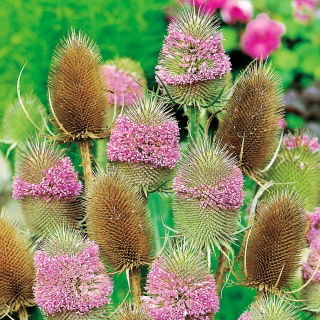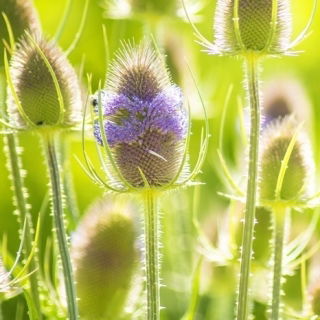The wild teasel (Dipsacus fullonum L.) is a biennial plant that in the wild grows in forests, brushwood, on balks and green belts alongside roads and at the riversides and water reservoirs. It grows rather tall and may reach 2 m in optimal conditions. The thick, angular stem is covered with thorns. The sharp tipped leaves are petioleless. The large thorny inflorescences are wild teasels most prominent decoration. These egg-shaped clusters of flowers consist of up to two thousand tiny purple or pink flowers. The marvellously scented blooms are eagerly visited by bees and butterflies.
The wild teasel is a highly productive melliferous plant. According to the research you can produce 300 kg of honey and 250 kg of pollen from one 1 hectare. It is an exceptional result and it is worth to take advantage of this plant's generosity and sow it in vicinity of apiaries, orchards and vegetable gardens. The wild teasel blooms in July and August. The plant develops the inflorescences in the second year after the seeding. The ripe seeds of this plant constitute a delicacy for birds, particularly goldfinches and tits. Apart from its melliferous value, the wild teasel offers high ornamental value. It is more and more often sown as an ornamental plant, as it looks great in larger arrangements. Its fruit can be used in dried compositions and can be dyed to various colours. The wild teasel has been gaining recognition as a medicinal plant lately. It shows antibacterial and anti-inflammatory properties that are used in healing Lyme disease.
Growing wild teasel is not difficult. The sow usually takes place in summer or early autumn, but seeding in the spring brings particularly good results. The seedlings would then develop dense leaf rosettes and a well developed root system. The wild teasel grows in every kind of soil, but prefers the moist, since it provides the plant with the best possible development conditions. Its development will not be hampered by a rocky soil. The plant prefers the full exposure to sunlight, but partial shade will not do it no harm.
Each package contains 1 kilogram of seeds of the melliferous wild teasel. The basic plant information and the sow-by date can be found on the package label.
- Height: 200 cm
- Use: melliferous plant; seeds as bird fodder; ornamental
- Blooming time: July - August
- Flower colour: purple or pink
- Vegetation form: biennial
- Foliage: dense rosettes
- Flower type: egg-shaped, thorny inflorescences
- Site: sunny or partial shade; any moist soil
- Weight: 1 kg
|
||||||||||









